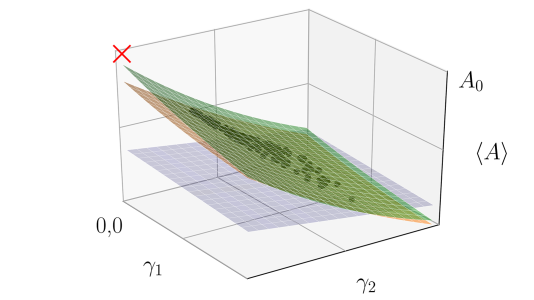
Two new techniques are presented that address two challenges in quantum computing – overcoming decoherence, or information loss, due to noise, which is inherent to quantum hardware, and accounting for and removing error in measured quantities from quantum algorithms.
The first technique recovers lost information by repeating the quantum process many times in sequence, with slightly different noise characteristics, and then analyzing the results. After gathering results by running the process many times in sequence or parallel, we plot a hypersurface where one axis represents the results of a measurement and the other two (or more) axes, different noise parameters. This hypersurface yields an estimate of the noise-free observable and gives information about the effect of each noise rate. Applying this technique eliminates quantum noise without the need for additional quantum hardware. The technique is versatile and can be done with separate quantum systems undergoing the same process at the same time. An algorithm could run in parallel on several small quantum computers, and, using this method, one could combine the results on the hypersurface and generate approximate noise-free observables. The results would help extend the usefulness of the quantum computers before decoherence sets in. We successfully performed a simple demonstration of the method on the Rigetti 8Q-Agav quantum computer.
The second technique reduces error on each individual qubit and sums the scaled difference from the results. It focuses on changing the error associated with each individual qubit or error source separately and is well suited to applications where the dominant noise source is environmental interactions. This method is flexible and can reduce environmental error from a measured observable, with potential in quantum sensing and quantum metrology.
DOI: 10.1103/PhysRevA.99.012338
DOI: 10.1038/s41534-019-0125-3
Work was performed in part at the Center for Nanoscale Materials.
About Argonne’s Center for Nanoscale Materials
The Center for Nanoscale Materials is one of the five DOE Nanoscale Science Research Centers, premier national user facilities for interdisciplinary research at the nanoscale supported by the DOE Office of Science. Together the NSRCs comprise a suite of complementary facilities that provide researchers with state-of-the-art capabilities to fabricate, process, characterize and model nanoscale materials, and constitute the largest infrastructure investment of the National Nanotechnology Initiative. The NSRCs are located at DOE’s Argonne, Brookhaven, Lawrence Berkeley, Oak Ridge, Sandia and Los Alamos National Laboratories. For more information about the DOE NSRCs, please visit https://science.osti.gov/User-Facilities/User-Facilities-at-a-Glance.
Argonne National Laboratory seeks solutions to pressing national problems in science and technology. The nation’s first national laboratory, Argonne conducts leading-edge basic and applied scientific research in virtually every scientific discipline. Argonne researchers work closely with researchers from hundreds of companies, universities, and federal, state and municipal agencies to help them solve their specific problems, advance America’s scientific leadership and prepare the nation for a better future. With employees from more than 60 nations, Argonne is managed by UChicago Argonne, LLC for the U.S. Department of Energy’s Office of Science.
The U.S. Department of Energy’s Office of Science is the single largest supporter of basic research in the physical sciences in the United States and is working to address some of the most pressing challenges of our time. For more information, visit https://energy.gov/science.